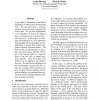COLING
2010
13 years 7 months ago
2010
We present a novel Evaluation Metric for Morphological Analysis (EMMA) that is both linguistically appealing and empirically sound. EMMA uses a graphbased assignment algorithm, op...
COLING
2010
13 years 7 months ago
2010
We describe an approach to automatically learn reordering rules to be applied as a preprocessing step in phrase-based machine translation. We learn rules for 8 different language ...
COLING
2010
13 years 7 months ago
2010
We use web-scale N-grams in a base NP parser that correctly analyzes 95.4% of the base NPs in natural text. Web-scale data improves performance. That is, there is no data like mor...
COLING
2010
13 years 7 months ago
2010
Emotion words have been well used as the most obvious choice as feature in the task of textual emotion recognition and automatic emotion lexicon construction. In this work, we exp...
COLING
2010
13 years 7 months ago
2010
We present an approach to model hidden attributes in the compositional semantics of adjective-noun phrases in a distributional model. For the representation of adjective meanings,...
COLING
2010
13 years 7 months ago
2010
A great deal of information on the Web is represented in both textual and structured form. The structured form is machinereadable and can be used to augment the textual data. We c...
COLING
2010
13 years 7 months ago
2010
In this paper, we propose an unsupervised approach to automatically synthesize Wikipedia articles in multiple languages. Taking an existing high-quality version of any entry as co...
COLING
2010
13 years 7 months ago
2010
In this paper we present a simplified shallow semantic parsing approach to learning the scope of negation (SoN). This is done by formulating it as a shallow semantic parsing probl...
COLING
2010
13 years 7 months ago
2010
We describe a new unsupervised approach for synonymy discovery by aligning paraphrases in monolingual domain corpora. For that purpose, we identify phrasal terms that convey most ...
COLING
2010
13 years 7 months ago
2010
As tokenization is usually ambiguous for many natural languages such as Chinese and Korean, tokenization errors might potentially introduce translation mistakes for translation sy...




